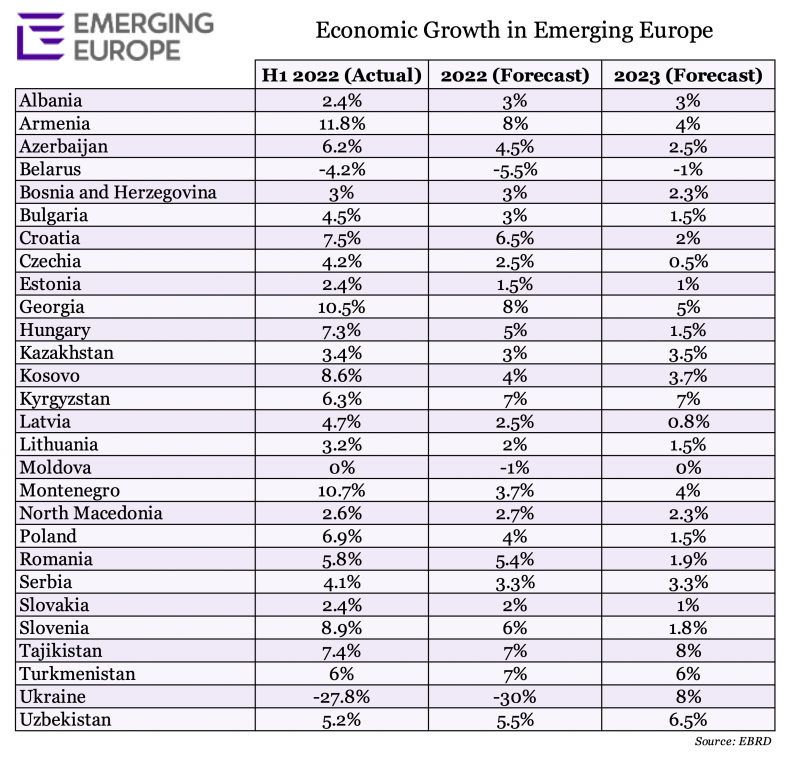With the exception of Ukraine, Belarus and Moldova, all countries in emerging Europe and Central Asia should escape recession in both 2022 and 2023.
Reduced supplies of gas from Russia and mounting inflation worldwide will slow economic growth further next year in emerging Europe, according to new forecasts from the European Bank for Reconstruction and Development (EBRD).
The projections, contained in the EBRD’s latest Regional Economic Prospects report, are subject to major downside risk should Russia’s war on Ukraine escalate or the volume of its gas exports decline even more.
- Sustainable, nature-positive reconstruction can make Ukraine more secure and resilient
- Time to reassess Ukraine’s macroeconomic strategy
- Emerging Europe’s resilience likely to fade as war and inflation pressures mount
The bank now forecasts gross domestic product (GDP) growth across its regions of three per cent in 2023, a downward revision of 1.7 per cent from its most recent report in May.
However, an upward revision to predicted growth this year is likely to deliver a gentler slowdown in real terms, with output next year a mere 0.5 per cent lower than forecast earlier this summer.
Output in the EBRD regions is now expected to grow by 2.3 per cent in 2022 after consumers in emerging Europe went on a post-pandemic spending spree in the first half of the year.
This temporarily boosted consumption, despite a fall in real wages, and led to a sharp widening of current-account deficits across central Europe.
“These are very worrying times for the EBRD regions and many advanced economies,” says EBRD Chief Economist Beata Javorcik.
“As we head towards winter, the economic cost of Russia’s war against Ukraine is growing clearer with every day that passes.
“Inflation may not have peaked in the EBRD regions as in many countries the increase in producer costs and high natural gas prices have not yet been fully reflected in consumer prices.”
A cold winter ahead?
The new Regional Economic Prospects report, entitled, A Cold Winter Ahead?, paints a stark portrait of the impact of the war on the EBRD regions’ energy markets, inflation and economies.
Since late February, gas prices in Europe have averaged around 2.5 times their 2021 level (in inflation-adjusted terms).
For many countries in the EBRD regions, higher gas prices imply increases in gas import bills equivalent to as much as 4-5 per cent of GDP, as economies are highly dependent on gas in their energy mix.
Gas accounts for the bulk of derived heat production in the EBRD regions. In some economies, gas is also an important source of electricity production. Even where electricity is not derived directly from gas, electricity and gas prices tend to move in parallel.
Average inflation in the EBRD regions reached 16.5 per cent in July, a level last seen in 1998.
Energy and food usually account for a higher share of the consumption of poorer households, which are experiencing even higher effective rates of inflation. Real wage growth has turned negative, on average, with greater falls in real incomes in south east Europe.
However, there are still wide variations in the impact of the war on different regions and countries.
Russia’s war on Ukraine will cause the latter’s economy to shrink by 30 per cent this year, the bank forecasts, a projection unchanged since May.
For 2023, the EBRD has lowered its forecast to a rebound of just eight per cent from the more robust 25 per cent growth forecast in the last report. The expectation back in May was that substantial recovery work would already be underway next year.

The regional outlook
Output in central Europe and the Baltic states is expected to increase 3.7 per cent in 2022. Upward revisions from May are down to strong outturns in the first half of the year. Growth is expected to slow sharply, to 1.3 per cent in 2023, on gas supply disruptions and spill-overs from slower growth in advanced Europe, in particular, Germany and Austria.
Similarly, output in the Western Balkans is expected to grow 3.2 per cent in 2022 and slow to three per cent in 2023 (revised down from May). The risks to the economic outlook have increased, particularly in light of countries’ fiscal vulnerabilities.
GDP in eastern Europe and the Caucasus (excluding Ukraine) is expected to expand by 4.6 per cent in 2022 and 2.5 per cent in 2023 as temporary stays by Russians boost consumption in Armenia and Georgia.
Output in Central Asia is expected to grow by 4.3 per cent in 2022 and 4.8 per cent in 2023. Upward revisions to both years relative to May reflect a boost to consumption driven by public-sector wage hikes, high remittance flows and a sharp increase in shadow trade with Russia, as well as gains in commodity exporters.
The EBRD’s forecast comes just two days after the Organisation for Economic Co-operation and Development (OECD) also warned that the global economy has lost momentum in the wake of Russia’s war of aggression in Ukraine, which is dragging down growth and putting additional upward pressure on inflation worldwide.
“GDP growth has stalled in many economies and economic indicators point to an extended slowdown,” said OECD Secretary-General Mathias Cormann.
“Inflationary pressures that were already present as the global economy emerged from the pandemic have been severely aggravated by the war. This has further driven rising energy and food prices that now threaten living standards for people across the globe.”
Unlike many news and information platforms, Emerging Europe is free to read, and always will be. There is no paywall here. We are independent, not affiliated with nor representing any political party or business organisation. We want the very best for emerging Europe, nothing more, nothing less. Your support will help us continue to spread the word about this amazing region.
You can contribute here. Thank you.



Add Comment